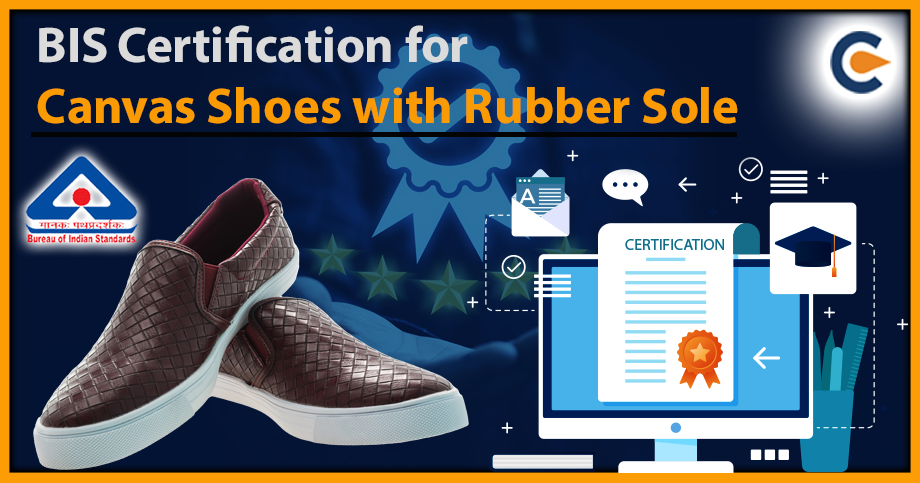The concept of product standardization is decades old. Almost every consumer’s products in India undergo an extensive quality checklist before appearing in the market. Several technical committees comprising industry leaders and subject matter experts in conjunction with the Indian Government have formulated Indian Standards (IS) for various products, including canvas shoes with rubber soles.
Let’s explore more about this product and its testing requirements under IS 3735:1996 and the process to obtain BIS Certification for Canvas Shoes.
BIS Compulsory Registration Scheme for Canvas Shoes with Rubber Sole
Rubber sole is a key raw material for different types of footwear, including canvas shoes.
Considering the ever-rising demand for canvas shoes, the Bureau of Indian Standard (BIS) has put this product in the compulsory registration scheme or ISI marking scheme.
That means every footwear manufacturer dealing with canvas shoes must secure this registration. The BIS license holder is liable to affix ISI marking on their product before selling them out.
Applying for BIS certification involves meeting various testing requirements mentioned under the IS 3735:1996. The section below unveils key requirements cited in this standard.
Highlighting Key Requirements Under the IS 3735:1996
IS 3735:1996 is an Indian standard that includes requirements for rubber soles around testing, quality, and material composition. The standard also governs the way the sample or product is selected from the finished lots for testing.
Anyway, let’s have a closer look at the main requirements under the aforesaid standard meant for canvas shoes with rubber soles.
Design and Size Requirements
- The pattern and design of the shoes shall be pursuant to the buyers’ demand.
- Shoe sizing shall be in accordance with IS 1638: 1969.
- The mass of one pair of footwear of size 8 shall not be more than 750 g with a tolerance of ± 25 grams for each bigger and smaller alternative respectively.
- Every shoe should have folds-free and wrinkle-free construction. There should be no sign of excessive surface marking and embedded foreign matter.
- The lock stitch machine should be used for stitching the shoe upper. The no. of stitches should be less than 30 per dm.
- The back seam of the shoe should be reinforced with a strip made up of canvas upper material.
Packaging Requirements
- Tissue paper can be used as a wrapping material for finished shoes. And as far as overall packaging is concerned, it must be made of cardboard cartons.
- The packed shoes can further be packed in wooden-based cases in an upright position. Every package must have footwear of the identical size only.
Requirements around Lab Establishment and Product Testing
A laboratory must have all the necessary resources and staff in place so that specified tests can be performed with ease. The mandatory tests for determining a shoe’s quality include;
- Adhesion Test
- Consolidation Test
- Tensile Test
- Dimension Test
Norms around Labeling On Canvas Shoes
Each shoe should be clearly marked with the following information on the insole face cover’s waist.
- Shoe Size
- Manufacturer’s name or trademark
- Year and month of supply
- Production year
As mentioned earlier, only BIS-certified manufacturers can use the ISI marking on their products.
The BIS accords the certification based on the comprehensive assessment of the production facility, quality control, testing capabilities, and so on.
Paperwork Concerning BIS Certification for Canvas Shoes with Rubber Soles
Following are the documents required for BIS Certification for Canvas Shoes with rubber soles
- Business registration documents.
- Factory license
- List of products requiring ISI marking
- Trademark registration if available.
- Lab testing report
- List of production machinery
- Production process flowchart
- List of lab equipment
- Authorization letter if the applicant is not the business owner.
How To Obtain BIS Certification For Canvas Shoes With Rubber Sole?
The following section discusses the process of securing BIS certification for Canvas shoes with rubber soles in detail.
Step 1: File Application Online
As with other licensing processes, the process of obtaining a BIS certificate starts with online application filing. The e-form for the BIS ISI certificate is available on the BIS portal[1].
After filling out the application, the applicant must upload the document as discussed shortly. This will be followed by the fee submission, which is the last step in the filing process.
Step 2: Paperwork Vetting and Sample Collection
Paperwork and facility inspection are vital phases in the BIS registration process. This is the phase where the BIS officials perform in-depth scrutiny of the production facility and documents based on the underlying standards to find any potential non-conformity.
As far as the on-site vetting is concerned, the officials will look out for the internal processes, production flow, equipment available, and testing equipment
At last, the official will select some samples (finished shoes) from the production lot(s) for lab testing.
Step 3: Sample Testing and Report Generation
The selected samples will then be examined by the BIS-acknowledged lab for any non-conformity.
As mentioned earlier, the lab will undertake the following tests on the sample(s) to determine whether they conform to the standard’s requirements.
- Adhesion Test
- Consolidation Test
- Tensile Test
- Dimension Test
After completing all these tests, a detailed report shall be prepared by the lab enclosing vital observations, which confirm whether the tested sample(s) passes the testing requirement or not.
Step 4: Collection of A Report By The Application
In this step, the applicant is required to collect the report from the lab and submit the same with the authority on time. It should be noted that the lab report stays valid for a limited timeframe. So, it is vital for you to ensure the timely submission of the lab report.
Step 5: Final Review and Grant of Certificate
The authority after receiving the lab report will conduct the final assessment of the same to ascertain whether the tested sample(s) qualifies for the certification or not.
Based on the assessment, the lab will decide whether to grant BIS ISI certification or not.
Conclusion
A BIS certification for canvas shoes with upper soles is a must-have legal permit for footwear makers. Those who successfully obtain this certification can use ISI labelling on their products.
Also Read:
Process Of Registering A Company Logo In India
10 Invaluable Advantages Of Trademark Registration
Process To Register A Logo Trademark In India – An Overview













